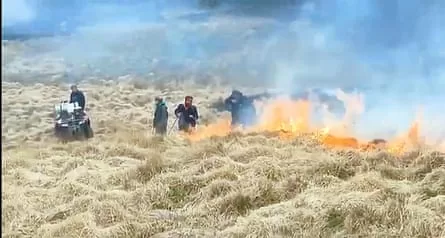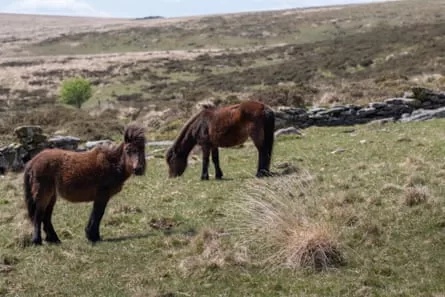The spot where the wildfire broke out could hardly have been worse. Cut Hill is one of the remotest and highest peaks on Dartmoor, miles from any road, a place of tussocky, ankle-turning terrain.
And the weeks of hot weather meant the molinia, the moorland grass, was as tinder dry as farmers can remember it at this time of year. Once it took hold, on Sunday, the fire raged.
“It was challenging, a really big one,” said Tracy May, a Dartmoor sheep farmer. “It’s so remote out there. It was an hour or more to reach the fire and when you got there, it was difficult to control.”
May coordinates the Dartmoor commoners’ firefighting team, local people who work with the fire service to tackle moorland fires, using generations’ worth of knowledge to guide the professionals on to the high ground and help them fight the flames.
It took the commoners and fire crews two days to put the fire out and despite their best efforts, 500 hectares (1,235 acres) of wildlife-rich moorland was burned in the biggest fire on Dartmoor for about five years.
Commoners described seeing ground-nesting birds, such as skylarks, red grouse and meadow pipits, fleeing their nests. “The adult birds were getting away but the fledglings in the nest couldn’t escape,” May said. “It’s an appalling time of year for this to happen. You’ve got all the lizards, the mice, whatever is there. It’s all burnt. It’s all gone. Devastating.”
The fire has focused attention nationally on the increasing problem of wildfires and locally on how the moor is managed, reinforcing the concerns of many commoners that restricted grazing regimes designed to protect the blanket bog mean the molinia is too high and a fire risk. “This should be the wake-up call,” May said.

She was alerted to the fire on Sunday afternoon and called out the commoners. About 80 are trained to fight fires alongside the Devon and Somerset fire and rescue service. “The commoners drop everything and go,” said May.
The commoners use “fogging units”, a pressure washer fitted with a lance to produce a fine spray that can penetrate the vegetation. One drives the quad bike, another works the lance and a third comes up behind with a fire-beater, making sure there are no flare-ups.
This fire was particularly fierce because of the scale of the “fuel load” – the amount of combustible material – on the moor. “What stops a fire is when it hits an area that’s been tightly grazed,” May said. “There was absolutely nothing to stop it.”
Limiting the fire to Cut Hill was vital. “If it went north, it could have reached all the way to Sticklepath [a village on the edge of the moor more than 5 miles away]. I’ve been saying for years: it’s not if we get a very big fire, it’s when. We’ll get one we won’t stop.”

Commoner Neil Cole, who stopped lambing duties to fight the fire, said it was one of the most demanding he had been involved in. “It was very hard work,” he said.
Cole has no time for rewilding, the large-scale restoration of areas such as Dartmoor, arguing that this landscape has been managed by humans for centuries. “It needs to be grazed by sheep, cattle, ponies. Otherwise the vegetation gets too thick and you get this sort of fire. There needs to be a rethink.”
after newsletter promotion
As well as harming the moor’s flora and fauna, there are concerns that a peatland restoration project in the area may have been compromised and prehistoric sites could have been damaged. Last year archaeologists excavated an early bronze age cist, or burial chamber, at Cut Hill.
Richard Drysdale, the director of conservation and communities at the Dartmoor national park authority, said its rangers, who also worked with the commoners and firefighters to tackle the fire, had not been able to assess the damage because military firing exercises were taking place there this week.
But he said birds such as dunlin, lapwing, skylark and cuckoo may have been affected, as well as adders, slow worms, lizards and beetles. “It’s a bit of a Noah’s ark.” Species that have vanished from other parts of south-west England are found on the moor.
The cause of the Dartmoor fire is not yet known. There were wild campers on the moor when it happened but there is no evidence they were to blame. Nevertheless, the park authority is urging people not to light camp fires or barbecues. The military is not suspected as it was not firing at the time and the commoners insist nobody was “swaling” – deliberately burning the moor to improve grazing areas.
Wildfires are not just a Dartmoor issue. According to the National Fire Chiefs Council, by the start of this month, fire and rescue services had responded to 439 wildfires since 1 January. That compares with 250 in the same period in 2022, 60 in 2023 and 44 in 2024.
In Devon, the Dartmoor Land Use Management Group is working through recommendations from a major review published in December 2023 on how the moor should be managed.
Drysdale said it was vital to find the right sort of grazing regime. “This wildfire really highlights the importance of having the right level of grazing in the right place.”
